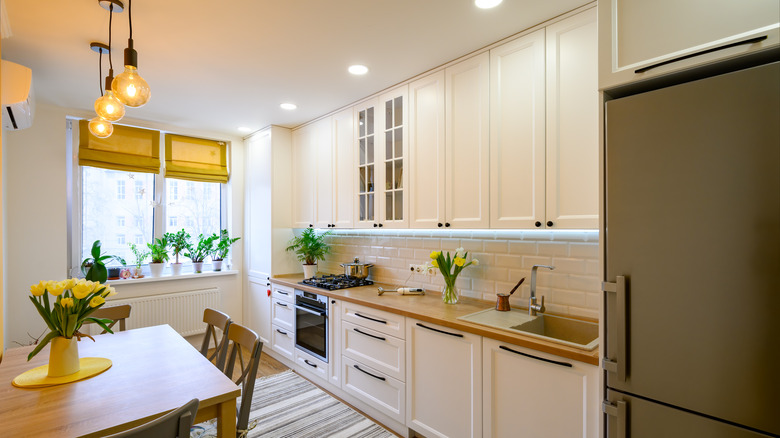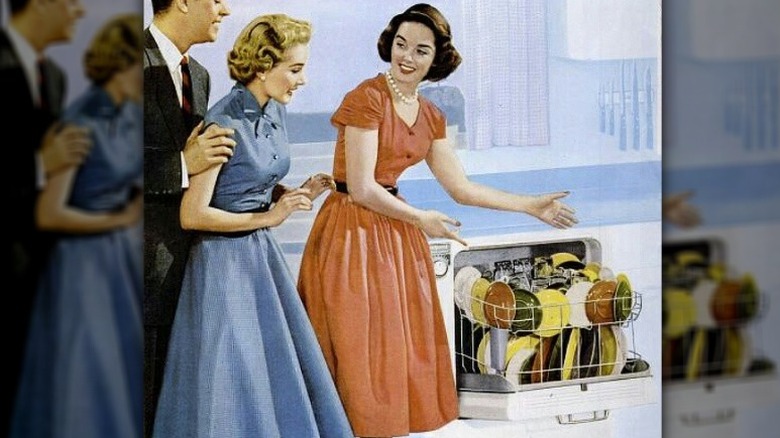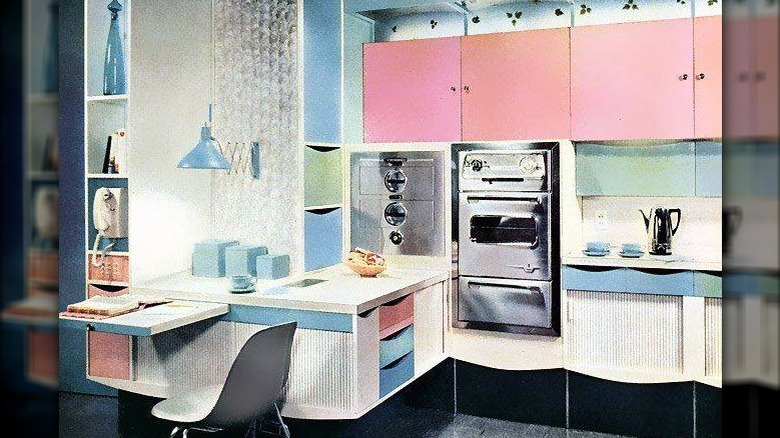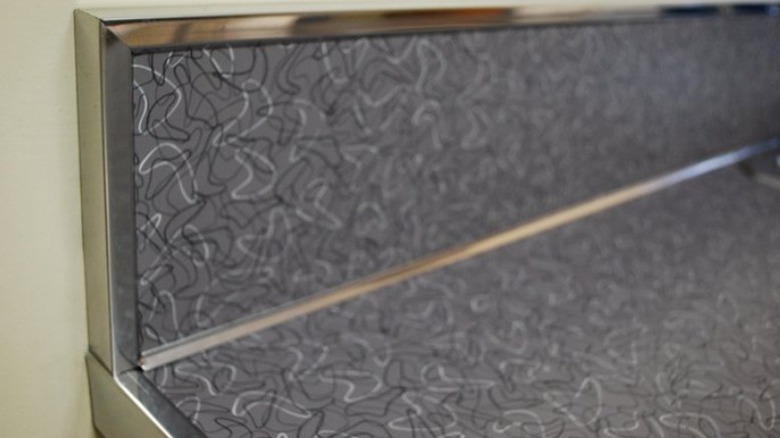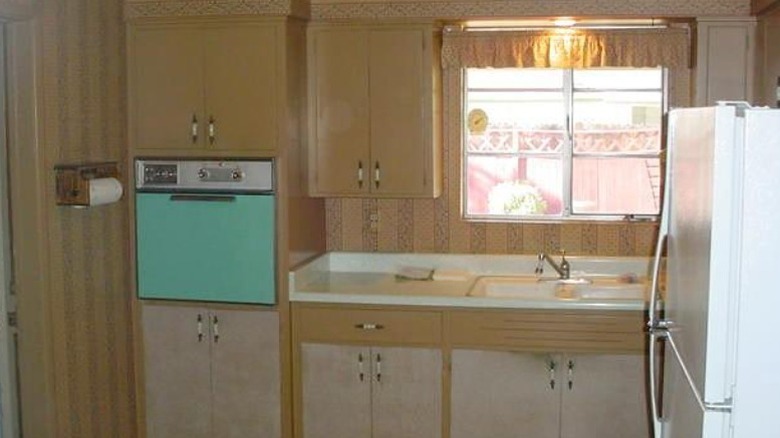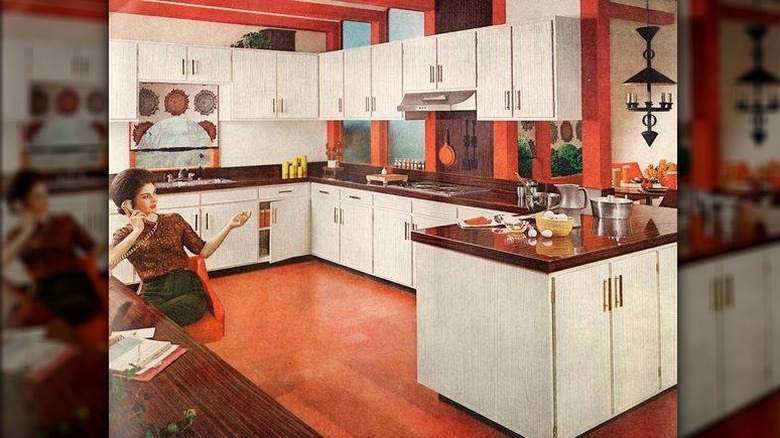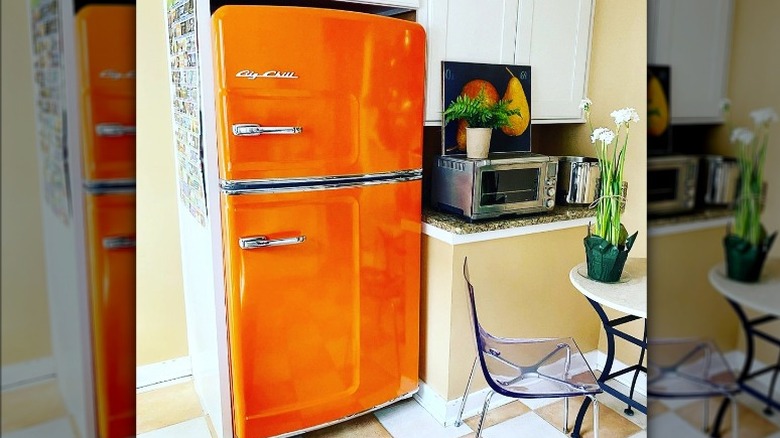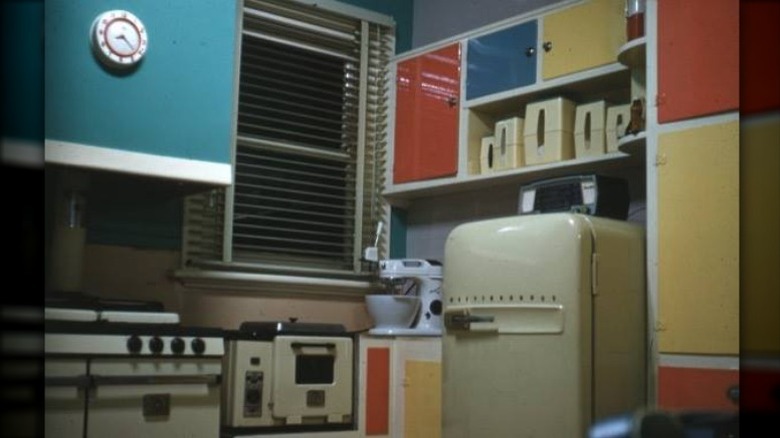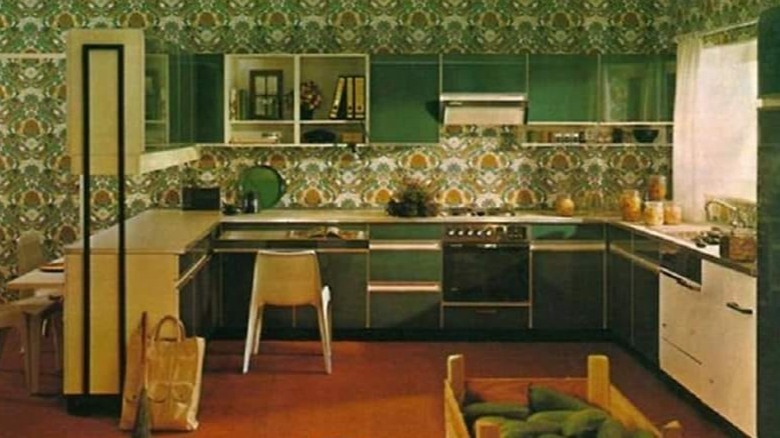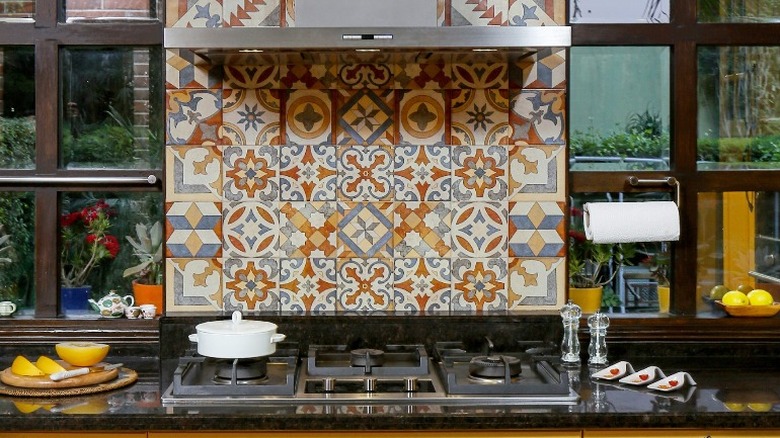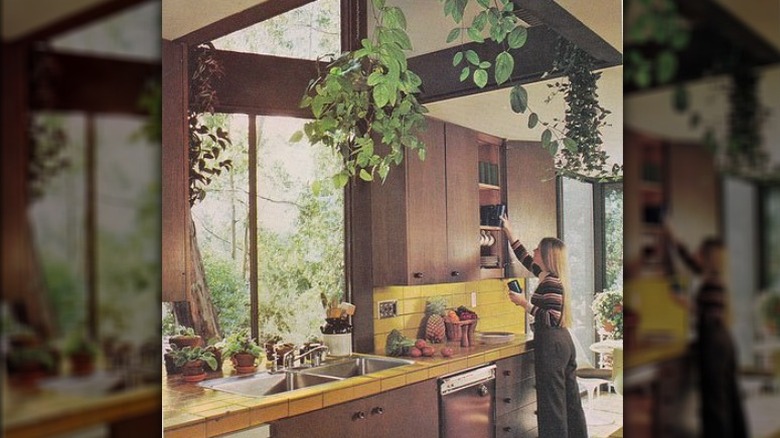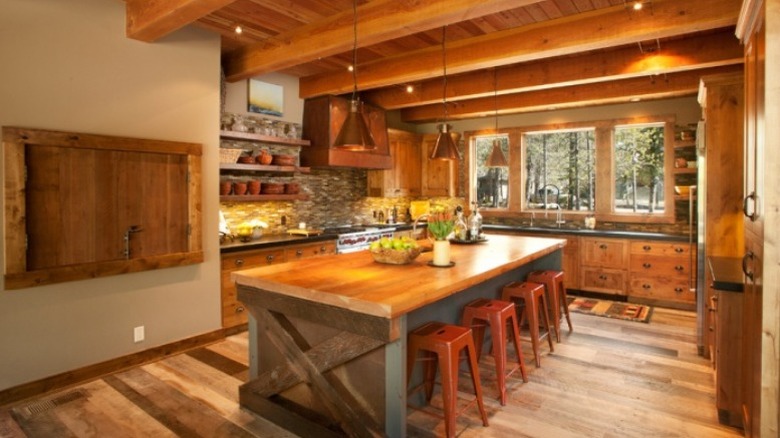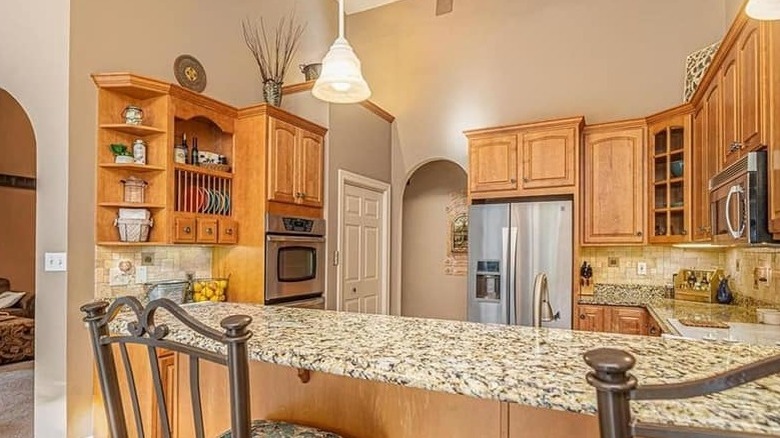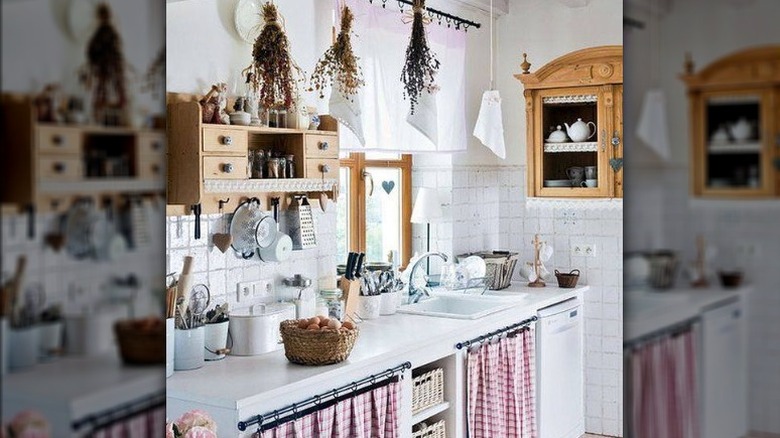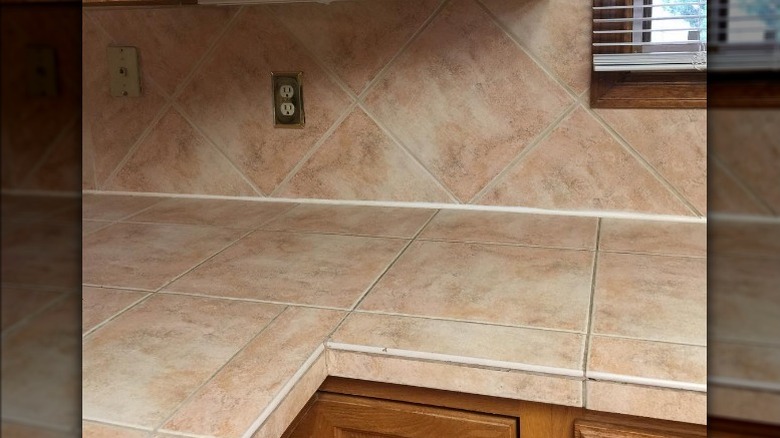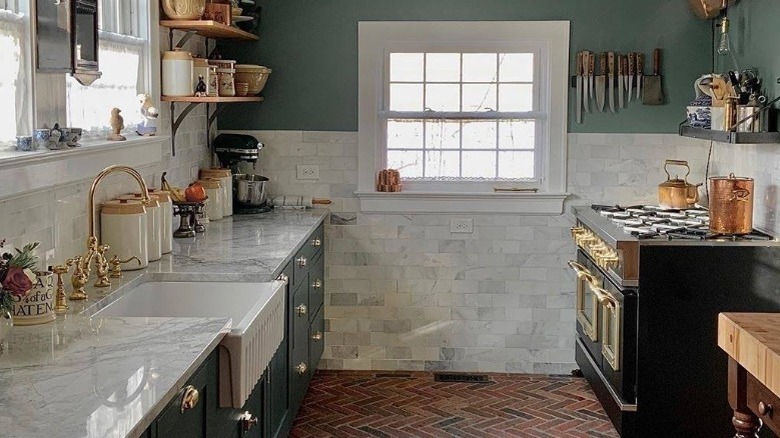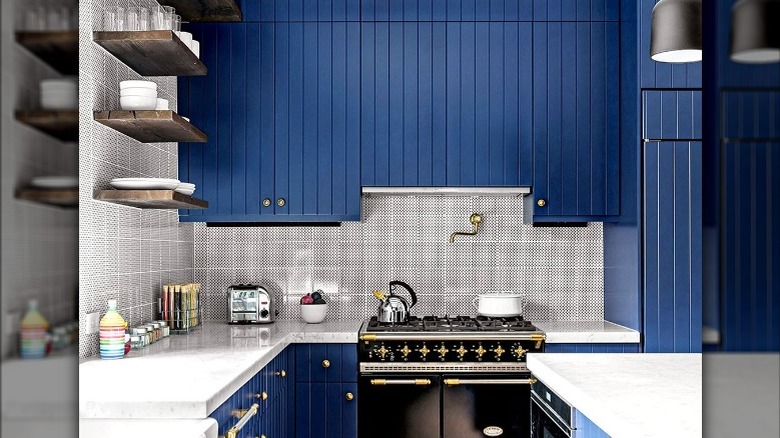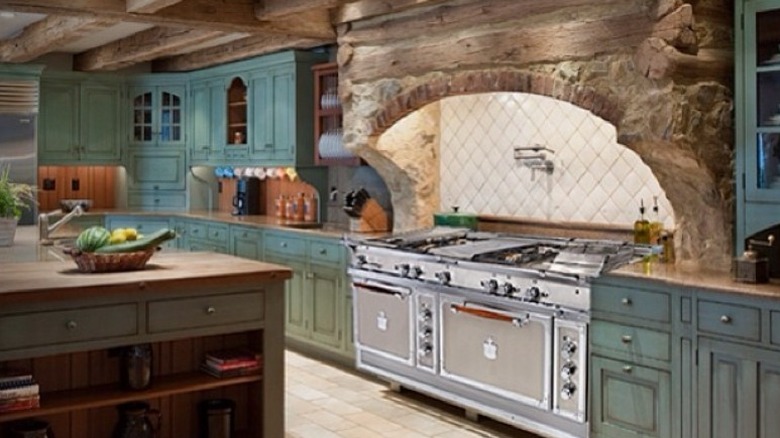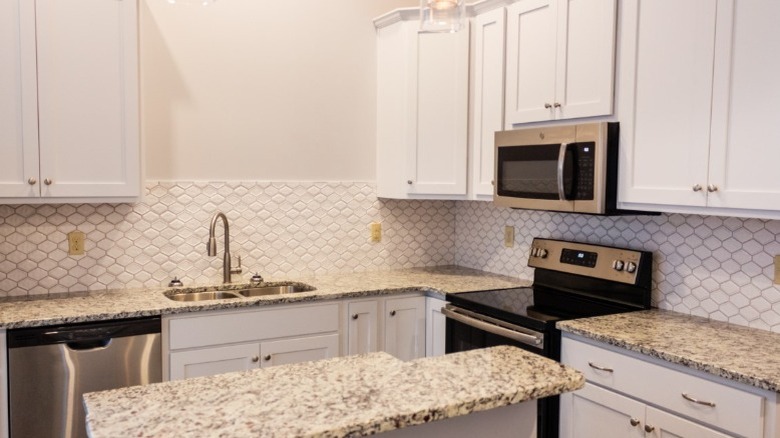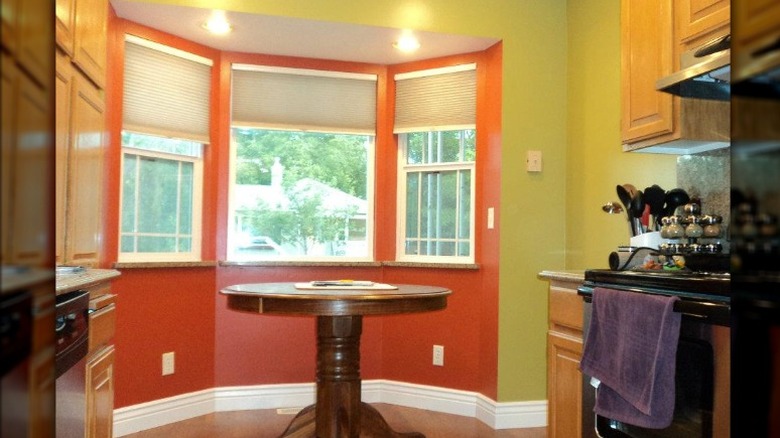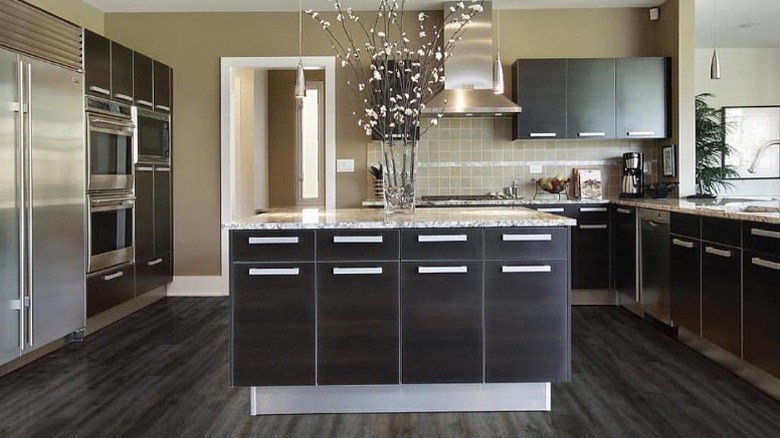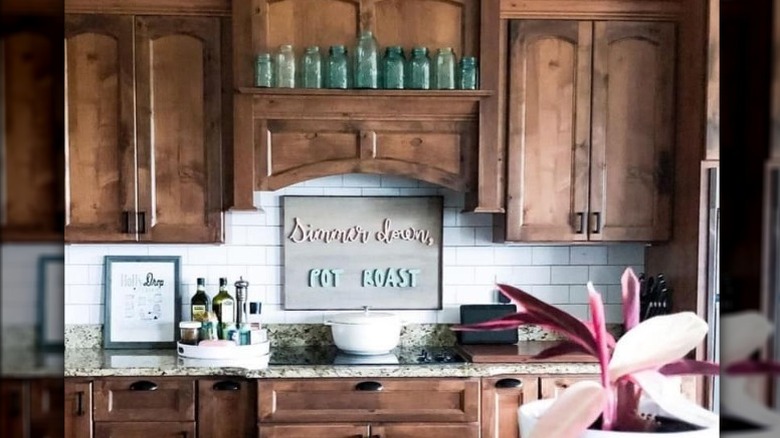How American Kitchens Looked The Year You Were Born
Kitchens are the epicenter of the home, a place for families to break bread, do homework, and experiment with the 30-minute dinner possibilities of combining a can of spaghetti sauce with a bag of frozen vegetables. Kitchen decor is constantly evolving, embracing new stylistic elements and gadgets to make spaces that are both functional and beautiful. While many people transform their kitchens into understated and chic oases, others derive inspiration from pop culture like "The Simpsons" or use the space to fully flex their creative muscles.
Although the current best kitchen trends are worth checking out, we can also learn a lot from the past. Specific styles, like rustic wooden cabinets and laminate, resurface over the decades in various forms. Others, like open kitchens and islands, have perennial staying power. Our time machine trip back to your childhood kitchen is bound to make you simultaneously cringe and covet the kitchens of yore.
1950-1952: Time-saving appliances
In the early 1950s, it was all about convenience and cutting-edge novelty, ushering in a brave new era of time-saving appliances like dishwashers. Although the machines were invented in the 1850s, primitive models were neither practical nor universally accessible (via Home Stratosphere). Fortunately, the 1950s proved a golden age for mommy's little helpers, and the domestic devices began popping up in higher-end homes fitted to kitchen counters for easy access and usability.
Popular Science notes that the dishwasher revolution was tied to a significant trend of kitchen efficiency and came alongside other advances like cold water taps and customizable counters. There were even some sci-fi adjacent trends like smart kitchens and super-powered ovens, although they never caught on quite to the effect that now-standard appliances like dishwashers did. Today, it's almost impossible to imagine a modern kitchen without a dishwasher, but these machines were transformative in the early 1950s.
1953-1955: Plenty of pretty pastel colors
1950s kitchens were anything but dull and drab. According to San Francisco Gate, they were awash with optimistic hues like bright pink, soothing lavender, and yellow. As the outlet notes, advances in modern technology made the kitchen a productive and relatively clean space, and this was reflected in the vibrant modern colors. It's also possible that the buttery yellows and vibrant greens and reds of 1950s kitchens were a nod to postwar prosperity and the promise of a new day.
This Old House identifies turquoise as one of the dominant colors of the time, and describes how the saturated hue played beautifully with '50s-era furnishing, laminate, and cutting-edge hardware. The entire effect was bold, put-together, and undeniably cheerful and welcoming. So, if your childhood kitchen was a riotous celebration of vivacious colors, you probably grew up in the early part of the 1950s — or at least your kitchen was designed at this time.
1956-1958: Boomerang-Pattern Formica
Formica was huge in the 1950s (via The Guardian), and most postwar homes had scores of wipeable, shiny surfaces in their kitchens. Although plenty of 1950s kitchens boasted the kind of dreamy saturated pastel Formica colors that dominated the walls and furniture, some went in a different direction. According to This Old House, boomerang-patterned Formica hit its stride during the 1950s. The playful pattern of interlocking and overlaying boomerang shapes cropped up everywhere, adorning counters and backsplashes with its whimsical design.
San Francisco Gate notes that the official name for boomerang-patterned Formica is Skylark. The design is highly identifiable both with the 1950s and the material itself. Although there were plenty of other patterns and styles in every color of the rainbow, the boomerang pattern stuck. Perhaps it was a nod to bold 1950s kitchen fashions or a subtle look ahead into what the swinging '60s would bring. Either way, the style was utterly iconic.
1959-1961: Wood or wood-veneer cabinets
Featured on the cover of the "Sears 1958 Kitchen Book," wood veneers took over the pretty pastels and rich summery hues of 1950s kitchens, becoming an enduring trend into the first few years of the 1960s. According to Arciform, wood veneer gained a coveted spot next to laminate and modern appliances, completing the look of the updated, state-of-the-art, modern postwar kitchen. Baby boomers might remember these monochromatic wooden designs, highlighted here and there with a touch of bright Formica or some inspired hardware.
Although the late '50s and early '60s were one of the first times when wooden everything came on the scene, it certainly wouldn't be the last. Kitchens continued to embrace a natural look in the following decades, including using even more wood and softer hues. The wood veneer trend of the end of the 1950s was a subtle movement toward nature-inspired kitchen designs.
1962-1964: Open-plan kitchens
Although open-plan kitchens might be falling slightly out of vogue (via My Domaine), they've had an excellent run over the decades. Issues aside, people still love the idea of sprawling open spaces without barriers between the kitchen and living room. The trend toward open kitchens really started in the 1960s (via Click Americana), facilitating more spacious environments and allowing for conversation between the dining room and kitchen.
The perks of open kitchens were virtually limitless, making tiny kitchens feel suddenly larger and more accommodating and even prompting airflow throughout the house. 1960s Revco, Inc.'s book "How to Plan a Trend-Setting Kitchen" visually illustrates how opening up your kitchen can double your space and provide more area for conversation and comfort across the two rooms. Even though the trend is waning, many home-buyers still desire open-plan spaces, proving that this kitchen idea is one of the greats (via My Domaine).
1964-1966: Bright and bold appliances
The mid-1960s were simply a groovier time. If you need proof, look no further than the bold-colored appliances of the day. Instead of boring white, black, or brushed silver appliances, 1960s fridges, dishwashers, and washing machines popped up in super-saturated, juicy tones like tangerine, teal, apple red, flamingo pink, deep blue, and green. According to CNET, these colors existed in the appliance sweet spot between the standard subdued fare of the 1950s and the nature-loving avocado tones of the 1970s.
As the outlet notes, these psychedelic-toned fridges could be the happy byproduct of GM owning Frigidaire, echoing the gorgeous color palette of popular cars at the time. Wherever the inspiration began, it was nearly impossible to step into a 1960s kitchen without running across a bright fridge, washing machine, or dishwasher. This is one trend that we hope makes a comeback to banish our tired neutral-colored appliances for good.
1967-1969: Spacious refrigerators
While bright and bold appliances were par for the kitchen course during the 1960s, refrigerators also underwent a transformation during this decade — they swelled. According to Big Chill, the 1960s were the age of frozen dinners and gigantic freezers, a reflection of the changing dynamics of the American family and slowly shifting gender roles. As Smithsonian Magazine points out, Americans began purchasing television sets in the late 1950s and 1960s, charting the course for one of the most convenient inventions in history: the TV dinner.
With the twin benefits of practicality and cost — plus celebrity endorsements from the likes of mega-stars such as Barbara Streisand (via Smithsonian Magazine) — TV dinners and frozen fare were all the rage. In addition, the slick, substantial refrigerators of 1960s kitchens were large enough to hold plenty of family-friendly meals and frozen add-ins for semi-homecooked meals, embracing a faster food revolution that would come to define the end of the 1960s (via National Museum of American History).
1970-1972: Avocado colored everything
The early part of the 1970s took a decidedly different spin, leaving colors like flamingo pink and sky blue behind and embracing Mother Nature in the form of deep yellows, browns, and avocado green. According to BBC, avocado complemented the overall environmental inclination of the 1970s, mingling with other homey and welcoming touches like rich shag carpets, rattan furniture, and homemade macramé decorations (via Elle Canada).
It's fitting that avocado green became one of the statement colors of the time because, especially in the latter part of the decade, the many 1970s aesthetics were typically naturally-based. Although the velvet and inflatable furniture designs of the 1970s don't seem to be making a comeback anytime soon, avocado green could be another story. According to The New York Times, this formerly dated color is getting a whole new breath of life as people are forgoing minimalistic kitchens for groovy green.
1973-1975: Bold backsplashes
The mid-1970s kitchen had its own sense of hip maximalism, thanks to fun backsplashes and cool tile work. According to Tile Club, the 1970s glam aesthetic benefitted from two distinct influences: natural colors and the disco era. As a result, these funky tile designs often featured 1970s colors like avocado, deep yellow, brown, and rustic orange, but with geometric patterns that made the backsplash or countertop stand out.
Additionally, 1970s tile work often relied on a deliberately mismatched aesthetic, combining complementary colors in unexpected patterns. While the general feel was usually the same, the look was slightly off-kilter and cool. If one of your cherished childhood memories is wandering into the kitchen and getting instantly hypnotized by the area behind your stove, you may just be a 1970s kid. Interestingly enough, tile work would resurface a few years later, proving the staying power of this quirky trend.
1976-1978: Natural elements and earth tones
Avocado green was just one of the ways that 1970s kitchens went full-on natural. According to Vogue, nods to Mother Earth were all the rage in the 1970s, and a lot of these elements are making a huge comeback today. The kitchens of the '70s had plenty of mellow earth tones like rich yellow, avocado green, and brown, as well as natural elements and plant life. These groovy designs reflected the rest of the home with its soft pillowy rattan and velvet furniture.
Overall, the 1970s was a time to explore different textures. While the decade might be infamous for some style faux-pas that unfortunately came to define the times (we're looking at you, inflatable furniture!), there's a lot we can learn from the '70s. For example, kitchens were downplayed and natural, with lots of wood and light. These warm aesthetics are a refreshing change from the stripped-down minimalism of today's kitchens.
1979-1981: Kitchen islands as a gathering place
Early '70s babies might have fond memories of doing their homework at the kitchen table island. According to Yahoo Finance, the current concept of a kitchen island has been around since the '50s, popping up in some shape or form to aid with the cooking and prep work. The reason that they came to define the late 1970s and early part of the 1980s was their sheer size. As Yahoo Finance notes, the kitchen island was a central hub in the early part of the 1980s, making this standalone feature one that you'll undoubtedly remember if you grew up in the decade.
By the 1980s, kitchen islands had swelled to the point where they almost masqueraded as dining room tables, taking the idea of an open kitchen to brave new levels. According to Dakan Homes, prominent islands were the center of kitchens in the '70s and '80s, and you'd be hard-pressed to find a modern home without one.
1982-1984: Honey oak cabinets
Honey oak cabinets were about as 1980s as spandex, colossal hair, and eyeball-singeing neon. This trend dominated the decade and went well into the 1990s, so there's a good chance that you probably had your very own kitchen filled with honey oak cabinets if you were born around this era. Although honey oak was the color and wood choice of the day during the latter part of the last century, these orange-tinged cabinets look a little bit out of place today.
According to Bob Vila, honey oak cabinets are among some of the most dated design features you can have in your home, rendering your kitchen more relic than refined. But although this color and style combo might be way out of fashion, some wood still seems to be a perennial favorite for kitchen decor. As Welsh Design Studio notes, stark wooden cabinets are making a comeback.
1985-1987: Country-style kitchens
The 1980s embraced nature in its own way, with country-style kitchens that delivered big on wholesomeness and charming cute touches. According to Homes & Gardens, this design was a staple of the '80s with details like luxe warm golden wood cabinets, delicate hardware, and homespun tile and fabric patterns. So if your childhood memories include a lot of gingham, rustic-looking tin decorations, hanging cookware items, and plenty of natural wood, you might have grown up with a 1980s country kitchen.
Houzz Magazine notes that these kitchens vied for a rustic, farmhouse feel, and suggests that you can achieve this epic mid-80s aesthetic by keeping the country style but eliminating the honey wood and other dated elements. While qualities of 1980s country kitchens, like the sweet innocent patterns and hanging kitchen equipment, certainly read as lovely and timeless, others should certainly be put onto the chopping block of history.
1988-1990: Tiled countertops
Just like wooden cabinets continue to pop up in some form or another throughout the ages, tile took center stage in the 1980s yet again, except this time it wasn't just for backsplashes. According to Long and Foster Company, tile had a brave new function during this decade of decadence; it was used for countertops. As the outlet notes, tile countertops have a lot to bring to the table. They're super easy to fix and replace, and they tend to be more cost-effective than other common materials.
On the flip side, having easily-stained pale grout in the same place you're preparing meals is not such a stellar idea. According to Forbes, tile countertops are also chip-prone and can quickly become bacteria-laden if not properly cleaned. Despite the definite upsides of easy installation and low cost, tile just couldn't make the cut, which is why you barely see this trend anymore.
1991-1993: Brass hardware and fixtures
If you want to spot a 1980s or 1990s kitchen, look at the color of the cabinets and hardware. According to The Washington Post, brass was big in the 1990s. While this brash metal looked pretty fabulous in kitchens three decades ago, it doesn't have the same allure today and it immediately dates a space. Fortunately, it's also something you can change fairly quickly if you want to upgrade your kitchen from retro 1990s to modern and refined.
The Washington Post notes that '90s brass fixtures don't have to send your kitchen back to the days before "Friends." Instead, you can simply switch out old brassy doorknobs or light fixtures for something in more modern silver or black. If you're feeling extra-DIY, you can even de-shine your brass with a good buffing. Natural-looking brass fixtures are a chic and updated alternative to the Day-Glo shimmering stuff.
1994-1996: French blue cabinets
Since everything old is new again when it comes to trends, the bright blue of the 1950s came back for round two in the mid-90s. This time it presented itself in the form of French blue cabinets. According to House Beautiful, this trend riffs on an old-world style with a splash of country charm thrown in. Although any clever color palette could evoke a country-style European kitchen, as we saw in the 1990s, the dominant color of the day was French blue.
Not only did French blue exemplify 1990s kitchen chic, but its appeal seems to be long-lasting. According to Elle Decor, variations of blue tones are super popular in the kitchens of today. Whether you opt for bold French blue cabinets like the kitchens of 25 years ago or choose modern blue accents to give your kitchen a feisty vibe, it's undoubtedly well-worth incorporating this dynamic hue into your kitchen design.
1997-1999: Tuscan-style kitchens
The French blue cabinets of a few years prior turned out to be a prelude for another European inspiration that was about to take the kitchen world by storm. Tuscan kitchens displaying massive, open, homey spaces with plenty of rich colors, natural wooden accents, and exposed stone, became intensely popular. If your kitchen looked more like Naples than New York growing up, you probably had a Tuscan-inspired decor.
According to Saratoga Living, in the late 1990s and early 2000s, Tuscan kitchens were defined by an artful interplay of rougher elements and modern amenities. They also had plenty of rustic touches, like artificial arches or exposed bricks. Although not mandatory, many Tuscan kitchens borrowed a page from the '80s playbook by incorporating large family-centric kitchen islands. These kitchen designs also came in various color schemes, but rich deeply saturated hues and natural tones like umber and brick were pretty standard (via Love to Know).
2000-2002: Granite countertops
Although Tuscan-style decor didn't totally disappear at the beginning of the millennium, there was a new kitchen fad that prominently took center stage: granite countertops. It became absolutely impossible to visit any chic circa-2000 kitchen without seeing vast swatches of granite-dominating islands, countertops, and sometimes even backsplashes.
This era's granite countertops were sleek, dark, and came in luxe earth tones or jet-black. Not only was granite an attractive style, but it was also highly functional. The material du jour for 2000s kitchens is hearty and stain-resistant, as long as you apply sealant from time to time (via Insider). On the flip side, granite is prone to unsightly chips and doesn't play too nicely with hot pots and pans. Still, 2000-era architects went gaga for granite, cementing its place as one of the central trends of the time and an enduring statement of luxury and exquisite kitchen decor.
2003-2005: Accent walls
According to Style by Emily Henderson, accent walls were one of the hottest pieces of decor in the early and mid-2000s, allowing homeowners to inject a room with personality without slathering the entire space in vibrant colors. The so-called color pop was a great way to add detail and interest, and all you needed was a tiny bit of paint and some elbow grease. Accent walls transcended all rooms of the home, making their way into stylish kitchens in the form of breakfast nooks and alcoves.
Although accent walls often came in complementary colors, some people really exercised their creative muscles with textured prints and designs, turning the entire space into an immobile work of art. Of course, part of the allure was that you could simply paint it back if you decided you didn't like it anymore. This versatility and ease of application are probably why accent walls are making a considerable resurgence (via Family Handyman).
2006-2008: Wooden laminate floors
According to Building Materials Reporter, laminate has a long, proud history of adorning floors since the late 1970s, with ever-changing patterns as styles and tastes have evolved. During the 2000s, laminate flooring got a whole new makeover, this time mimicking rustic wood flooring. The style took off tremendously. Not only could laminate appear like gorgeous true-wood flooring — at least from a distance — but it was also relatively cheap, and you could install it in a breeze (via The Spruce).
Although huge vistas of wooden laminate floors look a bit dated now, they were all the rage a decade and some change ago. If you have some DIY chops and time, you can update your old wooden laminate floors too. My Mindful Home offers an accessible, simple tutorial to transform your wooden kitchen laminate into wintery Scandinavian-chic white planks with just a simple coat of paint and a few hours.
2009-2010: Mason jar glasses, bowls, and decorations
America's love affair with mason jars is fraught with both admiration and disdain for the slightly-awkward, rustic, old-timely jars. As The Outline points out, mason jars are kind of tricky to sip from, and consuming a proper meal from them is next-level difficult. Still, a few short years ago, mason jars not only stood in for cups and plates but were also prominent decorative items in kitchens all across the United States.
Smithsonian Magazine notes that mason jars weren't always the darlings of hipster dinner parties. Once upon a time, they were pragmatic rather than whimsical. As late-aughts kitchens embraced the trend, mason jars evolved into a hipster staple (via The Atlantic). While some people welcomed the movement as charming and sustainable, others flocked to the internet to mock the mason jar and other hipster serving vessels that were more wacky than functional.
